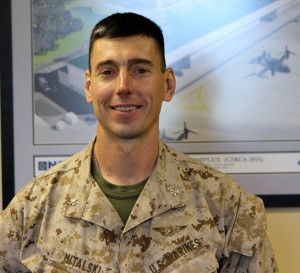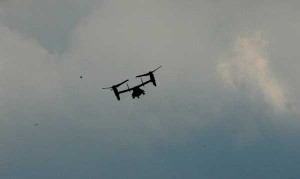2012-09-09 In a wide-ranging discussion with Lt. Col. Thomas “Ryder” Mitalski, Commanding Officer of VMM-263, we discussed the impact of the Osprey on the reshaping of USN-USMC operations. And we discussed as well the challenges of such change in con-ops upon the fleet and operational approaches.
Lt. Col. Mitalski is an experienced CH-46 pilot with more than 12 years of flying time in that helicopter. He has been involved with three ARG-MEU deployments with the CH-46 and has been with the V-22 since 2006, completing another two ARG-MEU deployments. And in this capacity his first deployment at sea was at the time of the Haitian earthquake relief aboard the USS Nassau in its last deployment.
The Osprey with its speed and range provides a very different capability for the sea-based force, but the full realization of what it brings to the fleet has taken some time.

SLD: Talk to me about your time in Haiti?
Lt. Col. Mitalski: We showed up in Haiti but really the Osprey was new to this type of operation and folks did not know what to do with us. The main port into Haiti was badly damaged but folks kept bringing humanitarian supplies in and then the challenge was to get it out of the port to areas where the supplies were needed.
We argued that if you used our base in Cuba to bring in the supplies needed, we could fly from there with the Osprey to wherever the assistance was needed, so point to point not overloading an already burdened port.
But this did not get very far, because we were such a new platform to this kind of operational environment,
So we did it once or twice, but we could never really convince the mission commanders that this was a way to depressurize the congested supplies, and that was frustrating to us.
Nor did we get a chance to go and land on the hospital ship because testing has not been done yet to certify us to land. It’s on a long list of air capable ships to be tested for the V22, and then once the testing is done, they’ll give it a stamp of approval.
But again, when you look at some of the assault port missions that we can do, it was frustrating to see that we couldn’t use the range and the speed of this airplane to save lives and reduce injury and so on because we couldn’t land them on the hospital ship.
SLD: The speed and range of the aircraft has provided significant operational flexibility to the ARG-MEU. Could you discuss this?

Lt. Col. Mitalski: It has. And the deployment of the Osprey aboard ships has led to a re-emergence of split ARG-MEU operations. One or two of the ships would split off and work with the Combatant Commander and the others would go off and do exercises or other missions.
In one case, we did disaggregated operations in which one ship was assigned to Sixth Fleet and another two were assigned to 5th Fleet. And the aviation assets were assigned appropriate to the command. We put Harriers together with Ospreys for strike missions and the other group used helos for a different set of missions.
SLD: This trend poses series challenges I would think to the Navy-Marine Corps team in terms of providing support to the aviation assets and the “Grunts” as well. What is your sense of these challenges?
Lt. Col. Mitalski: The problem is as you say, how to support assets.
The ARG-MEU is set up as an integrated entity with support focused on one ship or another for particular assets. And there is a real problem with the number of bodies trained to do specific support tasks.
For example, I have a avionics man and he works on the electronic and avionic devices on the aircraft. I have an ordinance man who works on the ordinance devices. I have an air framer who obviously does the airframes and so on and so forth. Some of those Military Occupational Specialist or MOS’s are what we call low density MOSs, so we don’t have many marines assigned to them because they can be assigned to a squadron, but work on any aircraft.
We then have to move them around a fleet if it is operating in a disaggregated manner. This is a challenge.
That also carries over with the groundside, in terms of where the grunts are positioned. We put a company on each ship basically. Your air assault company obviously is on the large ship where your small support aircraft are, but again we moved 53s over on a small deck, and we kept the V22s on the large ship, but we didn’t cross-deck the grunts. We ended up having to train another company over on the small deck to pick up the mission of the tactical recovery aircraft[commonly referred to as Combat Search and Rescue (CSAR)].
If we keep doing disaggregated operations – again driven by the speed and range of the Osprey as part of the ARG-MEU – we will have to change the structure of the ARG-MEUS, in terms of the personnel, the staffing and the equipment.
SLD: Will the demand for disaggregated operations remain steady or increase?
Lt. Col. Mitalski: The problem will be with a limited number of amphibious ships you are going to ask them to do more.
The demand from the Combatant Commanders for the ARG-MEU is very significant, so disaggregated operations could become the norm.
This will pose challenges.

